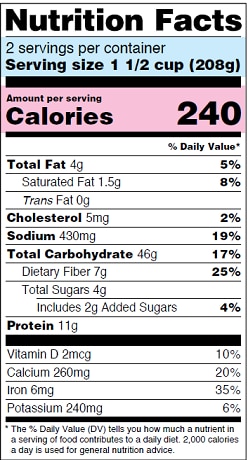Keep Active & Eat Healthy to Improve Well-being & Feel Great
On this page:
- Why should I move more and eat better?
- Should I talk to a health care professional before starting a physical activity program?
- How much physical activity do I need?
- How can I handle roadblocks to becoming more active?
- How can I eat healthier?
- How can reading the Nutrition Facts label help me?
- How can I handle roadblocks to healthy eating?
- How can I eat well when away from home?
- I can do it!
- Clinical Trials
Eating foods that are good for you and staying physically active may help you reach and maintain a healthy weight and improve how you feel. You also may find that moving more and eating better could help you keep up with the demands of your busy life and be there for the people who depend on you.
Why should I move more and eat better?
In addition to helping you reach and maintain a healthy weight, staying active and eating better may lower your chances of developing
- type 2 diabetes, or high blood sugar
- high blood pressure
- kidney disease
- heart disease
- stroke
- certain kinds of cancer
But improving your health isn’t the only reason to move more and eat better. You may also
- have more energy for work, play, and family
- feel better about yourself
- manage stress better
- set a good example for your children, friends, and other family members
- tone your body—without losing your curves
Your family, friends, and coworkers can be a great source of support as you work to adopt healthier habits. Ask them to join your efforts. Being healthy is important for them, too. By making healthy choices together, you may find it’s easier to move more and eat better.
Should I talk to a health care professional before starting a physical activity program?
Most people don’t need to see a health care professional before starting a less intense physical activity, like walking. However, if you have chronic conditions, such as diabetes—or symptoms of chronic conditions—talk with a health professional about the type and amount of physical activity that’s best for you.

How much physical activity do I need?
To maintain or improve your health, aim for 150 minutes per week—or at least 30 minutes on all or most days of the week—of moderate physical activity. Moderate activities are ones that you can talk—but not sing—while doing, such as brisk walking or dancing. These activities speed up your heart rate and breathing.
If you haven’t been active, work slowly toward the goal of 150 minutes per week. For example, start out doing light or moderate activities for shorter amounts of time throughout the week. You can gain some health benefits even if you do as little as 60 minutes of moderate physical activity a week.
For best results, spread out your physical activity throughout the week. Even 10 or 15 minutes at a time counts. And any amount of physical activity is better than none at all.
To lose weight and keep it off, you may need to be even more active. Shoot for 300 minutes per week, or an hour a day 5 days a week. On at least 2 days per week, also try activities that strengthen your muscles. Examples of these activities include workouts using hand weights or rubber strength bands.
How can I handle roadblocks to becoming more active?
Becoming more active isn’t easy. Different people may have different reasons for finding it hard to get moving. If some of the roadblocks below sound familiar, try the suggested tips to help you overcome them.
“I don't have time.”
Try sneaking a few minutes of physical activity at a time into your day. Get started by making these small changes in your daily routine:
- Break your physical activity up into two or three 10-minute walks a day, if you can do so safely near work or home.
- Take regular breaks from sitting at the computer or watching TV. Get up, move, and stretch by lifting your hands over your head. Twist side to side.
- Schedule time to be active as you would a hair or work appointment, and stick to your plan.
“I'm going to ruin my hairstyle.”
If you avoid being active because you don’t want to ruin your hairstyle, try
- a natural hairstyle, short haircut, braids, twists, locs, or wigs
- wrapping a scarf around your hair; when you’re done with your workout, remove the scarf and let your hair air dry.
“It costs too much.”
You can be active without spending a lot of money—or any money at all:
- Look for free or low-cost classes and activities in your community.
- Walk in a mall, or walk or jog in a park or on a school track.
- Gather friends and neighbors from your apartment complex and hold regular group workout sessions.
- Find workout videos online and on YouTube if you have internet service—or DVDs at the library—and work out at home.
“Physical activity is a chore.”
Some people may be put off by physical activity, especially if they haven’t been active for a while or got hurt and are afraid of getting injured again. However, with some planning and effort, physical activity can be enjoyable:
- Try being active with your kids—walk, jump rope, play flag football or tag, or toss a softball. Children should get an hour of physical activity each day.
- Get a friend or family member to go biking or take a dance class with you. You can cheer each other on, have company, and feel safer when you’re outdoors.
- Enjoy friendly competition with family and friends by setting a weight-loss challenge or entering a walking, biking, or running event for a worthy cause.

How can I eat healthier?
An example of a healthy meal includes vegetables, fruits, and small portions of protein and whole grains. These foods provide fiber and important nutrients such as vitamins and minerals. When planning meals for you and your family, think about including
- a salad or other different-colored vegetables, such as spinach; sweet potatoes; and red, green, orange, or yellow peppers
- fat-free or low-fat milk and milk products, or nondairy products such as almond or rice milk
- different-colored fruits, including apples, bananas, and grapes
- lean beef, pork, or other protein foods, such as chicken, seafood, eggs, tofu, or beans
- whole grains such as brown rice, oatmeal, whole-wheat bread, and whole-grain cornmeal
Treats are okay if you have them once in a while. Just don’t eat foods such as candy, ice cream, or cookies every day. Limit sweet treats to special occasions, and keep portions small. Have one cookie or piece of candy, rather than trying every kind.
Remember that alcohol, juices, soda, and other sweet drinks have a lot of sugar and calories.
If you can’t have milk or milk products because you have trouble digesting lactose, the sugar found in milk, try lactose-free milk or yogurt. Besides milk and milk products, you can get calcium from calcium-added cereals, juices, and drinks made from soy or nuts. Eating dark green leafy vegetables such as collard greens and kale, and canned fish with soft bones like salmon, can also help you meet your body’s calcium needs.
How can reading the Nutrition Facts label help me?
Reading the information on the Nutrition Facts label can help you choose foods high in fiber, vitamins, and minerals; and low in sodium, added sugars, and unhealthy fats, which federal dietary guidelines (PDF, 3.94 MB) recommend Americans limit.

The U.S. Food and Drug Administration (FDA) Nutrition Facts label appears on most packaged foods and tells you how many calories and servings are in a box, can, or package. The label also shows how many nutrients are in one food serving. The FDA made changes in 2016 to update the Nutrition Facts label.
How can I handle roadblocks to healthy eating?
Eating healthy foods may seem hard when you don’t have time to cook or are on a tight budget. Try these tips to get past roadblocks that may keep you from eating well:
“I don't have time to cook healthy meals; I don’t really know how to cook.”
Eating healthy doesn’t have to take a lot of time. Nor do you need to be a chef to prepare healthy meals. Here are ways you and your family can eat better without spending a lot of time preparing meals:
- Buy frozen or precut veggies and add them to a salad or veggie wrap with pita bread for a quick meal. Or microwave the veggies and add them to whole-grain pasta.
- When you cook, make enough for extra meals. Casseroles with veggies and whole grains, and a whole cooked chicken, may last a few days so you don’t have to cook another meal every day. Be sure to freeze or refrigerate leftovers right away to keep them safe to eat.
- If you don’t feel comfortable cooking, try something easy, like combining your favorite fresh, frozen, or canned veggies to make a stir-fry. Check out websites, videos, and online blogs for more recipe ideas as your confidence builds.

“Eating well costs too much.”
You don’t have to spend a lot of money to eat well:
- Avoid buying single portions of snacks, yogurt, and other foods, which costs more. Instead, buy in bulk or larger sizes and divide into smaller portions as needed.
- Check newspaper ads for food sales. Clip coupons or print them from websites.
- Buy fruits and vegetables in season, when they’re cheaper.
- Try canned beans such as black, butter, kidney, pinto, and others. They’re loaded with protein, cost less than meat and fish, and make quick and easy additions to your meals.
How can I eat well when away from home?
Here are some ways to make healthy food choices when you’re on the go:
- Avoid heavy gravies, salad dressings, or sauces. Leave them off or ask for them on the side so you can control how much you eat.
- Try to avoid fried foods and fast food. Instead of fried chicken, order baked, broiled, or grilled chicken, or a turkey sandwich with whole-grain bread.
- Share a meal with a friend or take half of it home.
- Take healthy snacks with you to work, such as apples or fat-free yogurt with fruit.
I can do it!
Set specific goals and move at your own pace to reach them. For example, instead of “I’ll be more active,” set a goal such as “I’ll take a walk after lunch at least 2 days a week.” Ask your family, friends, and coworkers to help you. They can join you, cheer you on, help you get back on track after a setback, and be there to celebrate your successes!
No matter what, keep trying. You can do it!
Clinical Trials
The National Institute of Diabetes and Digestive and Kidney Diseases (NIDDK) and other components of the National Institutes of Health (NIH) conduct and support research into many diseases and conditions.
What are clinical trials, and are they right for you?
Clinical trials are part of clinical research and at the heart of all medical advances. Clinical trials look at new ways to prevent, detect, or treat disease. Researchers also use clinical trials to look at other aspects of care, such as improving the quality of life for people with chronic illnesses. Find out if clinical trials are right for you.
What clinical trials are open?
Clinical trials that are currently open and are recruiting can be viewed at ClinicalTrials.gov.
This content is provided as a service of the National Institute of Diabetes and Digestive and Kidney Diseases
(NIDDK), part of the National Institutes of Health. NIDDK translates and disseminates research findings to increase knowledge and understanding about health and disease among patients, health professionals, and the public. Content produced by NIDDK is carefully reviewed by NIDDK scientists and other experts.
The NIDDK would like to thank:
Anne E. Sumner, M.D., NIDDK; National Institute of Minority Health and Health Disparities (joint appointment)

